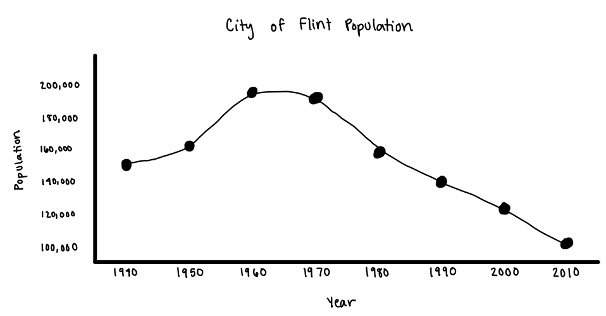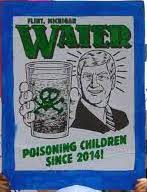Background:
In the late 20th century, Flint Michigan was prosperous and an icon city for the automobile industry. General Motors Corporation had originated from Flint generating many auto manufacturing jobs for inexperienced workers (Dandaneau 1996). The decline of Flint began in the 1980s and extended into the mid 1990s due to the termination and relocation of General Motors manufacturing jobs. Many people were left unemployed and others moved from the city completely. This created a 48% decrease in the population from 1960-2010 yet, the percent of black population increased to over half (Chavez et. al. 2016). Flint Michigan’s population became approximately 100,000 people and 45% of its residents live below the poverty line. Nearly one in six of the city homes have been abandoned and the average household income was less than half of the national level at that time (Chavez et. al. 2016). As a result, the tax revenues decreased, but all services in the city still cost the same amount of money as before, causing financial problems for the local government. In an effort to budget, the city of Flint switched their water supply that was coming from Detroit Water, specifically Lake Huron to the Flint River (Campbell et.al. 2016). The city believed that this would help them save money while the construction of a new water system was being produced.
At the time, the interior of the water pipes from which the water was coming from had not been treated with any anti corrosion chemicals. Lead can enter water when a chemical reaction occurs in plumbing materials containing lead; called corrosion; dissolving or wearing away metal from pipes. The reaction to lead is severe when the water has high acidity or a low mineral content (Denchak 2018). The loss of tax revenue led to a decrease in the city’s infrastructure and capabilities, combined with the lack of choices within Michigan’s regulatory bodies causing a perfect storm of events that lead to the Flint water crisis.

Figure 1. Illustration of the population of Flint Michigan over the years. Recorded 48% decrease in population from 1940 to 2010. Figure by Victoria Chesnakov.
Summary:
Per the timeline released by the Michigan State Government, the city council of Flint, Michigan voted in March of 2013 to switch municipal water distribution from Detroit Water and Sewage Department (DWSD) to Karengodi Water Authority (KWA) (FWATF, 2016a). In response, DWSD issued a termination notice effective in one year from April 2013, requiring Flint to begin its own water treatment by April of 2014. Water treatment was switched to Flint river in April of 2014 as an interim response to the uncompleted KWA connection, with concerns raised by Flint Utilities department over the plant’s quality control abilities. Results of the first 6-month monitoring period of lead and copper levels in Flint drinking water, ending December 2014, showed 90th percentile of samples contain six parts-per-billion (pbb) lead, requiring pipe corrosion control to stop the leaching as per the Environmental Protection Agency (EPA) Lead and Copper Rule (LCR). Flint was not notified of the results until the end of March 2015. In August 2015, a report on lead concentration levels in Flint drinking water from an independent analysis by Virginia Tech professor Marc Edwards stated that of the 48 samples, concentrations at 5 ppb were seen in nearly half and over 15 ppb in fourteen others (FWATF, 2016b). Simultaneously, the second 6-month analysis by the city of Flint showed 11 ppb in the 90th percentile of samples taken. It was at this point that corrosion control steps were implemented by Michigan Department of Environmental Quality (MDEQ), the main regulatory body concerning environmental issues on the state scale. A second water analysis conducted by Professor Marc Edwards showed that of the 252 samples total thus far, the 90th percentile contained 25 ppb of lead with a few samples having greater than 100 ppb and one over 1000ppb (Edwards, 2015). It should be noted that due to the long-term, adverse neurological effects of lead even at low concentrations, the permissible limit of exposure set by the EPA is zero with an action level of 15 ppb in drinking water in greater than 10% of homes as outlined in the Lead and Copper Rule of 1991 (EPA, 2020).
Examining Injustice:
The Flint water crisis is a prime example of how the government and other agencies value monetary gain over human life. The water crisis began with the water source switch to the Flint river to save money. A river that is known to contain toxic pollutants due to run off from industrial plants (Flint’s toxic industrial “..”, 2021). There was little to no research done on the impacts of this before the switch. Where the city did not have corrosion control systems that could have prevented the high levels of lead in the water supply (EPA, 2021) . This led to detrimental events that could have been fixed if proper techniques were used. However, city and state officials along with other agencies, failed to intervene and were dismissive when there was a public outcry from Flint residents. Flint is a low-income area that has a large population of African-Americans (Campbell et al, 2016). These residents were subjected to using water that was classified as hazardous waste, even when notifying the proper authorities of high lead levels (After blowing the whistle “..”, 2016).
Environmental justice is a concept that ensures that regulations and policies of environmental laws are enforced for everyone no matter the race or income level (Learn about Environmental “..”, 2021). Flint residents were victims of environmental injustice by having the basic human need of water stripped away from them. Even with several violations of the Safe Drinking Water Act, exceeding levels of lead that went against the Lead and Copper rule, and an outbreak of Legionnaires disease that caused multiple deaths (Lawrence, 2016). This disease is a severe case of pneumonia that causes lung inflammation (Eldstein, 1998). This is caused by the bacteria legionella that is commonly found in lakes or rivers, but can grow and spread in water systems if left untreated (CDC, 2021).There was no immediate action to resolve these issues until it reached national media attention. It can be further argued that if the population had a higher income level the crisis would have been resolved at a rapid rate (Butler et al, 2016). This depicts that the lack of enforcement of these laws heavily impact lower income communities of color.
In response to the Flint water crisis, the EPA is currently revising its Lead and Copper rule (EPA proposes lead rule change “..”, 2018). Revisions to be included are improving corrosion control treatments, and proposing additional protocols when lead levels are high and corrosion control isn’t effective (Butler et al, 2016). The EPA will also have regulation on sampling of lead levels and the site requirements, and replacement of lead service lines (Butler et al, 2016) . These improvements can further prevent problems that were encountered in Flint, but the previous laws also took similar measures. The problem is not entirely dependent on the content of these laws and regulations, but the enforcement of them in disenfranchised communities. There is no use of added regulations of prevention if those in power can pick and choose who it applies to. Until, authoritative figures are held accountable for their involvement in environmental injustice events like this will continue to ensue.
The Flint water crisis started in 2014 and ended in 2019, but the city still faces issues concerning water and trust in its governing officials ( Key moments in Flint, 2021). To understand the injustices the residents endured, and how officials continued to willfully turn a blind-eye to the crisis a timeline visual is provided.The following is a timeline of events that occurred over the five year period where the city of Flint faced turmoil for having high levels of lead in water.

Figure 2. Timeline of the events involved in the Flint Michigan water crisis,2014 – 2021. Figure by Victoria Chesnakov and Jamyahn White
References
1,700 residents of Flint, Michigan sue EPA over water crisis. 2017 Jan 31. Reuters. [accessed 2021 Nov 5]. https://www.reuters.com/article/us-michigan-water-idUSKBN15F2IG.
Adams D. 2015 Oct 8. Toxic lead levels found in water at three Flint schools. mlive. [accessed 2021 Nov 5]. https://www.mlive.com/news/flint/2015/10/three_flint_schools_water_exce.html.
After blowing the whistle on Flint’s water, EPA “rogue employee” has been silent. Until now. 2016 Jan 22. Michiganradio.org. [accessed 2021 Nov 5]. https://www.michiganradio.org/news/2016-01-21/after-blowing-the-whistle-on-flints-water-epa-rogue-employee-has-been-silent-until-now#stream/0.
After ignoring and trying to discredit people in Flint, the state was forced to face the problem. 2015 Dec 16. Michiganradio.org. [accessed 2021 Nov 5]. https://www.michiganradio.org/news/2015-12-16/after-ignoring-and-trying-to-discredit-people-in-flint-the-state-was-forced-to-face-the-problem#stream/0.
AG nessel announces $600M preliminary settlement for flint water civil lawsuits. Michigan.gov. [accessed 2021a Nov 5]. https://www.michigan.gov/ag/0,4534,7-359–537235–,00.html.
Butler LJ, Scammell MK, Benson EB. 2016. The flint, Michigan, water crisis: A case study in regulatory failure and environmental injustice. Environ Justice. 9(4):93–97.
Campbell C, Greenberg R, Mankikar D, Ross RD. 2016. A case study of environmental injustice: The failure in Flint. Int J Environ Res Public Health. 13(10):951.
Charges against 3 in Flint water crisis “only the beginning.” 2016 Apr 20. CNN. [accessed 2021 Nov 5]. https://www.cnn.com/2016/04/20/health/flint-water-crisis-charges/index.html.
Cdc.gov. [accessed 2021g Nov 5]. https://www.cdc.gov/legionella/about/causes-transmission.htm.
Denchak M. Flint water crisis: Everything you need to know. Nrdc.org. [accessed 2021 Nov 5]. https://www.nrdc.org/stories/flint-water-crisis-everything-you-need-know.
Edelstein PH. 1998. Legionnaires’ disease. N Engl J Med. 338(3):200–201.
Edwards M, Roy S, Rhoads W. 2015. Flint Water Study Updates. Flintwatersudy.org. [accessed 2021 Nov]. http://flintwaterstudy.org/information-for-flint-residents/results-
for-citizen-testing-for-lead-300-kits/
Egan P, Spangler T, Detroit Free Press. 2016 Jan 16. President Obama declares emergency in Flint. Detroit Free Press. [accessed 2021 Nov 5]. https://www.freep.com/story/news/local/michigan/2016/01/16/president-obama-declares-emergency-flint/78898604/.
Emery A. 2015 Oct 17. Flint reconnects to Detroit water, may take 3 weeks to clear all pipes. mlive. [accessed 2021 Nov 5]. https://www.mlive.com/news/flint/2015/10/flint_reconnecting_to_detroit.html.
EPA proposes lead pipe rule changes after 20 years, but some advocates say it doesn’t go far enough. 2019 Oct 10. CNN. [accessed 2021 Nov 5]. https://www.cnn.com/2019/10/10/politics/epa-lead-water-rules-update/index.html.
EPA. 2020. Understanding the Lead and Copper Rule. EPA.org. [accessed 2021 Nov]. https://www.epa.gov/sites/default/files/2019-10/documents/lcr101_factsheet_10.9.19.final_.2.pdf
Epa.gov. [accessed 2021h Nov 5]. https://www.epa.gov/sites/default/files/2016-01/documents/1_21_sdwa_1431_emergency_admin_order_012116.pdf.
Epa.gov. [Accessed 2021i Nov 5]. http://(https://www.epa.gov/newsreleases/epa-awards-100-million-michigan-flint-water-infrastructure-upgrades.
Erb R, Detroit Free Press. 2015 Jan 23. Detroit Free Press. Detroit Free Press. [accessed 2021 Nov 5]. https://www.freep.com/story/news/local/michigan/2015/01/22/water-woes-latest-hit-flint/22193291/.
Flint water crisis Fast Facts. 2016 Mar 4. CNN. [accessed 2021 Nov 5]. https://www.cnn.com/2016/03/04/us/flint-water-crisis-fast-facts/index.html.
Flint water crisis/recovery efforts. Cityofflint.com. [accessed 2021b Nov 5]. https://www.cityofflint.com/state-of-emergency/.
Flint water lead amounts improve, below federal limits. 2017 Jan 24. CNN. [accessed 2021 Nov 5]. https://www.cnn.com/2017/01/24/health/flint-water-crisis/index.html.
Flint—at long last—will receive funding for new water pipes. Nrdc.org. [accessed 2021c Nov 5]. https://www.nrdc.org/media/2016/161210.
Flint’s toxic industrial legacy. Columbia.edu. [accessed 2021d Nov 5]. https://www.publichealth.columbia.edu/public-health-now/news/flints-toxic-industrial-legacy.
flintwaterstudy. 2015 Sep 11. Test Update: Flint River water 19X more corrosive than Detroit water for Lead Solder; Now What? Flintwaterstudy.org. [accessed 2021 Nov 5]. http://flintwaterstudy.org/2015/09/test-update-flint-river-water-19x-more-corrosive-than-detroit-water-for-lead-solder-now-what.
flintwaterstudy. 2015 Sep 30. COMMENTARY: MDEQ mistakes and deception created the Flint water crisis. Flintwaterstudy.org. [accessed 2021 Nov 5]. http://flintwaterstudy.org/2015/09/commentary-mdeq-mistakes-deception-flint-water-crisis/.
Fonger R. 2014 Jun 28. Flint City Councilman Wantwaz Davis says he’ll lead protest at City Hall. mlive. [accessed 2021 Nov 5]. https://www.mlive.com/news/flint/2014/06/post_389.html.
Fonger R. 2014 Sep 6. Flint issues boil water advisory for section of the city after positive test for total coliform bacteria. mlive. [accessed 2021 Nov 5]. https://www.mlive.com/news/flint/2014/09/flint_issues_boil_water_adviso.html.
Fonger R. 2014 Oct 14. General Motors shutting off Flint River water at engine plant over corrosion worries. mlive. [accessed 2021 Nov 5]. https://www.mlive.com/news/flint/2014/10/general_motors_wont_use_flint.html.
Fonger R. 2015 Jan 3. City warns of potential health risks after Flint water tests revealed too much disinfection byproduct. mlive. [accessed 2021 Nov 5]. https://www.mlive.com/news/flint/2015/01/flint_water_has_high_disinfect.html.
Fonger R. 2015 Mar 24. Emergency manager calls City Council’s Flint River vote “incomprehensible.” mlive. [accessed 2021 Nov 5]. https://www.mlive.com/news/flint/2015/03/flint_emergency_manager_calls.html.
Fonger R. 2015 Nov 17. Class action lawsuit claims Snyder, Flint put water cost above safety. mlive. [accessed 2021 Nov 5]. https://www.mlive.com/news/flint/2015/11/class_action_lawsuit_claims_sn.html.
Fonger R. 2018 Aug 9. Expert says TTHM levels in Flint water were immediate evidence of trouble ahead. mlive. [accessed 2021 Nov 5]. https://www.mlive.com/news/flint/2018/08/expert_says_initial_tests_were.html.
FWATF. 2016a. Flint Water Timeline: Key Dates. Michigan.gov. [accessed 2021 Nov]. https://www.michigan.gov/documents/snyder/FlintWaterTimeline_FINAL_511424_7.pdf
FWATF. 2016b. Flint Water Advisory Task Force Final Report. Michigan.gov. [accessed 2021 Nov].https://www.michigan.gov/documents/snyder/FWATF_FINAL_REPORT_21March2016_517805_7.pdf
Groups petition EPA for emergency response to Flint, MI drinking water contamination. Nrdc.org. [accessed 2021e Nov 5]. https://www.nrdc.org/media/2015/151001-0.
Lawrence O. Gostin JD. 2016 May 17. Lead in the Water: A tale of Social and Environmental Injustice. Jamanetwork.com. doi:10.1001/jama.2016.5581. [accessed 2021 Nov 5]. https://jamanetwork.com/journals/jama/article-abstract/2521956.
Learn about Environmental Injustice. Epa.gov. [accessed 2021f Nov 6]. https://www.epa.gov/environmentaljustice/learn-about-environmental-justice.
Leaked internal memo shows federal regulator’s concerns about lead in Flint’s water. 2015 Jul 13. Michiganradio.org. [accessed 2021 Nov 5]. https://www.michiganradio.org/health/2015-07-13/leaked-internal-memo-shows-federal-regulators-concerns-about-lead-in-flints-water#stream/0.
Michigan and Flint agree to replace 18,000 home water lines by 2020. 2017 Mar 28. CNN. [accessed 2021 Nov 5]. https://www.cnn.com/2017/03/27/us/flint-settlement/index.html.
Michigan governor’s decision to end bottled water for Flint deeply troubling. Nrdc.org. [accessed 2021f Nov 5]. https://www.nrdc.org/media/2018/180406.
Michigan will end Flint’s free bottled water program. 2018 Apr 7. CNN. [accessed 2021 Nov 5]. https://www.cnn.com/2018/04/07/us/flint-michigan-water-bottle-program-ends/index.html.
Moore K. Addressing flint’s water concerns: Water system questions & answers and related documents. Cityofflint.com. [accessed 2021 Nov 5]. https://www.cityofflint.com/2015/01/15/city-of-flint-water-system-questions-and-answers/.
Newsroom W. 2015 Jul 9. Flint’s mayor drinks water from tap to prove it’s safe. Wnem.com. [accessed 2021 Nov 5]. https://www.wnem.com/news/flints-mayor-drinks-water-from-tap-to-prove-its-safe/article_bad3b738-63f5-56d3-bcb7-52b40d591b20.html.
“Our mouths were ajar”: Doctor’s fight to expose Flint’s water crisis. 2016 Jan 21. CNN. [accessed 2021 Nov 5]. https://www.cnn.com/2016/01/21/health/flint-water-mona-hanna-attish/index.html.
Spangler T, Detroit Free Press. 2016 Mar 6. E-mails shed light on EPA’s role in Flint water crisis. Detroit Free Press. [accessed 2021 Nov 5]. https://www.freep.com/story/news/local/michigan/flint-water-crisis/2016/03/05/e-mails-shed-light-epas-role-flint-water-crisis/80576406.
The Associated Press. 2021 May 14. Key moments in Flint, Michigan’s lead-tainted water crisis. Associated Press. [accessed 2021 Nov 5]. https://apnews.com/article/us-news-health-michigan-rick-snyder-flint-7295d05da09d7d5b1184b0e349545897.
Waldrop T, Romine T, Sutton J. 2021 Jan 14. The story behind the Flint water crisis. CNN. [accessed 2021 Nov 5]. https://www.cnn.com/videos/us/2017/02/01/flint-water-crisis-explained-jpm-orig.cnn.
What are U.s. standards for lead levels? 2021 Feb 9. Cdc.gov. [accessed 2021 Nov 5]. https://www.atsdr.cdc.gov/csem/leadtoxicity/safety_standards.html.
Zahran S, McElmurry SP, Kilgore PE, Mushinski D, Press J, Love NG, Sadler RC, Swanson MS. 2018. Assessment of the Legionnaires’ disease outbreak in Flint, Michigan. Proc Natl Acad Sci U S A. 115(8):E1730–E1739.

Provide Feedback